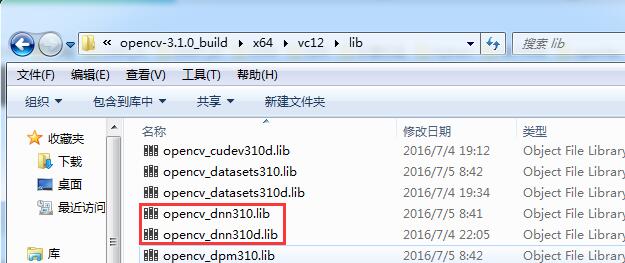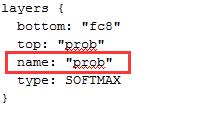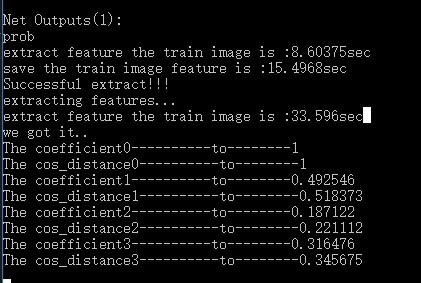opencv -dnn人脸识别
随着深度学习的发展,opencv3.1也可以直接调用caffe或者torch。下面是使用opencv的dnn模块来进行人脸识别:
1:编译opencv3.1
首先下载opencv源码https://github.com/opencv/opencv
下载Cmake https://cmake.org/download/
下载opencv的
具体的camke过程可以参考这篇博客:
http://www.cnblogs.com/jliangqiu2016/p/5597501.html
编译完成后可以把不需要的文件删除仅保留include bin lib 文件即可。


编译好的opencv3.1和普通opencv的配置过程一样:
opencv_aruco310.lib
opencv_bgsegm310.lib
opencv_bioinspired310.lib
opencv_calib3d310.lib
opencv_ccalib310.lib
opencv_core310.lib
opencv_cudaarithm310.lib
opencv_cudabgsegm310.lib
opencv_cudacodec310.lib
opencv_cudafeatures2d310.lib
opencv_cudafilters310.lib
opencv_cudaimgproc310.lib
opencv_cudalegacy310.lib
opencv_cudaobjdetect310.lib
opencv_cudaoptflow310.lib
opencv_cudastereo310.lib
opencv_cudawarping310.lib
opencv_cudev310.lib
opencv_datasets310.lib
opencv_dnn310.lib
opencv_dpm310.lib
opencv_face310.lib
opencv_features2d310.lib
opencv_flann310.lib
opencv_fuzzy310.lib
opencv_highgui310.lib
opencv_imgcodecs310.lib
opencv_imgproc310.lib
opencv_line_descriptor310.lib
opencv_ml310.lib
opencv_objdetect310.lib
opencv_optflow310.lib
opencv_photo310.lib
opencv_plot310.lib
opencv_reg310.lib
opencv_rgbd310.lib
opencv_saliency310.lib
opencv_shape310.lib
opencv_stereo310.lib
opencv_stitching310.lib
opencv_structured_light310.lib
opencv_superres310.lib
opencv_surface_matching310.lib
opencv_text310.lib
opencv_tracking310.lib
opencv_ts310.lib
opencv_video310.lib
opencv_videoio310.lib
opencv_videostab310.lib
opencv_viz310.lib
opencv_xfeatures2d310.lib
opencv_ximgproc310.lib
opencv_xobjdetect310.lib
opencv_xphoto310.lib
在opencv的源码中提供了dnn的test.cpp
下面具体分析代码:
/* Find best class for the blob (i. e. class with maximal probability) */
获取prob层的输出:实际意义为测试图片所对应与标签的概率值。resize成一个列向量,然后排序,输出最大值和最大值所对应的位置。

void getMaxClass(dnn::Blob &probBlob, int *classId, double *classProb)
{
Mat probMat = probBlob.matRefConst().reshape(1, 1); //reshape the blob to 1x1000 matrix
Point classNumber;
minMaxLoc(probMat, NULL, classProb, NULL, &classNumber);
*classId = classNumber.x;
}相关系数函数:一种相似性度量用于判断两个人的相似性距离。
float mean(const std::vector<float>& v)
{
assert(v.size() != 0);
float ret = 0.0;
for (std::vector<float>::size_type i = 0; i != v.size(); ++i)
{
ret += v[i];
}
return ret / v.size();
}
float cov(const std::vector<float>& v1, const std::vector<float>& v2)
{
assert(v1.size() == v2.size() && v1.size() > 1);
float ret = 0.0;
float v1a = mean(v1), v2a = mean(v2);
for (std::vector<float>::size_type i = 0; i != v1.size(); ++i)
{
ret += (v1[i] - v1a) * (v2[i] - v2a);
}
return ret / (v1.size() - 1);
}
// 相关系数
float coefficient(const std::vector<float>& v1, const std::vector<float>& v2)
{
assert(v1.size() == v2.size());
return cov(v1, v2) / sqrt(cov(v1, v1) * cov(v2, v2));
}cos相似性距离函数:
//cos 相似性度量
float cos_distance(const std::vector<float>& vecfeature1, vector<float>& vecfeature2)
{
float cos_dis=0;
float dotmal=0, norm1=0, norm2=0;
for (int i = 0; i < vecfeature1.size(); i++)
{
dotmal += vecfeature1[i] * vecfeature2[i];
norm1 += vecfeature1[i] * vecfeature1[i];
norm2 += vecfeature2[i] * vecfeature2[i];
}
norm1 = sqrt(norm1);
norm2 = sqrt(norm2);
cos_dis = dotmal / (norm1*norm2);
return cos_dis;
}下面是主函数:
/**/
//
//
#include importer;
try //Try to import Caffe GoogleNet model
{
importer = dnn::createCaffeImporter(modelTxt, modelBin);
}
catch (const cv::Exception &err) //Importer can throw errors, we will catch them
{
std::cerr << err.msg << std::endl;
}
//! [Create the importer of Caffe model]
if (!importer)
{
std::cerr << "Can't load network by using the following files: " << std::endl;
std::cerr << "prototxt: " << modelTxt << std::endl;
std::cerr << "caffemodel: " << modelBin << std::endl;
std::cerr << "bvlc_googlenet.caffemodel can be downloaded here:" << std::endl;
std::cerr << "http://dl.caffe.berkeleyvision.org/bvlc_googlenet.caffemodel" << std::endl;
exit(-1);
}
//! [Initialize network]
dnn::Net net;
importer->populateNet(net);
importer.release(); //We don't need importer anymore
//! [Initialize network]
//! [Prepare blob]
//===============进行训练样本提取=======================可修改====================
//========================五个人,每人一张照片====================================
std::vector 里面我有所修改,本来提取的是fc8层的,后来改成fc7层4096维特征。

这速度真喜人!!!!!!!!提取个特征就要8秒!!!!!!!
1:程序的改进方向:
1:保存提取的特征为dat文件,这样可以预先训练,直接测试即可
2:程序输出的是Bolb格式的数据,保存数据占用的时间比较长,可以修改一下。
3:还是使用caffe for windows吧!
下面是一些参考链接:
http://blog.csdn.net/mr_curry/article/details/52183263
http://docs.opencv.org/trunk/d5/de7/tutorial_dnn_googlenet.html
http://docs.opencv.org/trunk/de/d25/tutorial_dnn_build.html